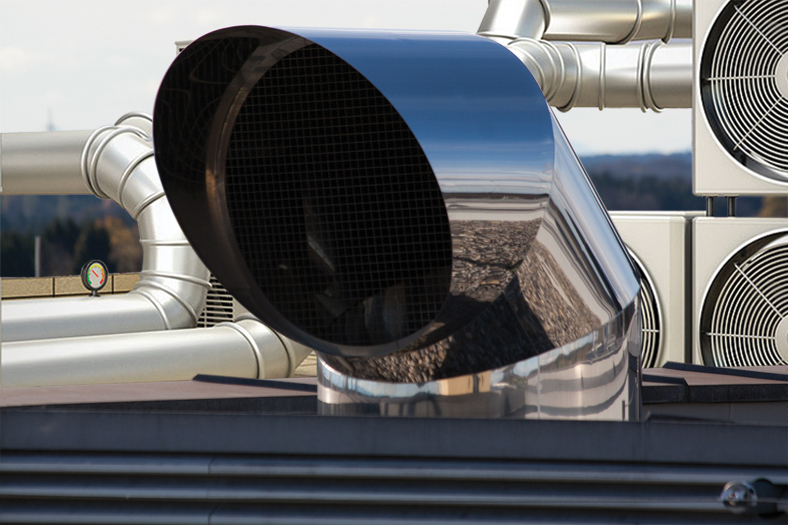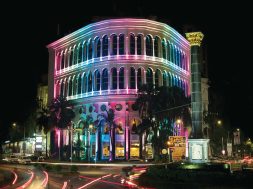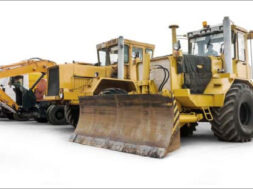
An overview on most advanced solution for cooling high-rise buildings
In this feature we would be describing about the state-of-the art solutionS for cooling high-rise buildings.
BITZER CSVH3: refrigerating capacity up to 660 kilowatts
With its CSVH3 series, compressor specialist BITZER offers a range of compact screw compressors for highly efficient water chillers for air conditioning and process cooling. The speed-regulated compressors with integrated frequency inverters feature impressively high performance and increased full and part load efficiency.
The BITZER CSVH3 series of compact screw compressors is based on the proven engineering, motor technology and electronics of the CSV series and has a very wide applications range, from air-cooled chillers for air conditioning and process cooling to heat pumps. The CSVH3 series with an integrated refrigerant-cooled frequency inverter offers maximum seasonal energy efficiency and a wide capacity control range. The robust engineering of the screw compressor in combination with active monitoring of the application limits optimises the highest operational standard in reliability whilst also providing system operators with an overview of all relevant operating parameters.
The CSVH38 achieves a refrigerating capacity of up to 660 kW (R134a, +5/50°C) with a displacement of up to 1,156 m3/h. The compressors work within a wide range of control from approx. 20 to 100 per cent of the refrigerating capacity.
“The compact screw compressors from the CSVH3 series are especially suitable for systems that frequently operated under part-load. These compressors achieve also impressively high full-load efficiency and enable OEM customers to develop liquid chillers meeting the highest international energy efficiency standards like the European Ecodesign Directive, the Chinese standard GB19577:2015 as well as the American standard ASHRAE 90.1,” informs Harvinder S Bhatia, Managing Director, BITZER India Pvt. Ltd.
Variable Speed Technology
Danfoss’ expertise in the cooling industry spans over 9 decades wherein the comapny has been focussed on making modern life easier by providing effective technology and solutions that energy efficient thereby reducing the environmental and economic cost across industries. “In Air Conditioning, the company’s latest innovation is the Variable Speed Technology, by which the compressor works with a variable frequency drive and the system runs on different frequencies to match varying load requirements. This helps in saving power to the tune of 25 per cent, be it for industrial or residential use,” states Ravichandran Purushothaman, President, Danfoss Industries Pvt. Ltd.
He adds, “With the right kind of technology, it is possible to explore avenues for every building to be converted to a green building. Our latest innovations such as the VLT HVAC drives, pressure and temperature valves, and controls aiding in building infrastructure the smart way and ensure that buildings ‘get more out of less’ through efficient utilisation of energy.”
The government initiatives such as ‘Make in India’ have helped in the creation and promotion of new technologies which have contributed to increasing the global competitiveness within the industry. On that note, the company is proud of the fact that its Turbocor Compressor, that was developed as a part of the ‘Make in India’ initiative is now being exported to the rest of the world, including China which is considered to be the biggest export hub in the world.
“The award winning applications is a high efficiency oil-free centrifugal compressor that can provide extremely high energy savings for HVAC systems. It has the ability to reduce energy consumption up to 35-50 per cent of a commercial HVAC system. This in turn helps in cutting down the overall energy consumption by over 30 per cent,” informs Purushothaman.
Air-Conditioning system (up to 54HP)
Hitachi being a technology major and one of the most premium brand in Indian Air Conditioner industry, is constantly working on new cutting edge technology in its product categories which comprises of room AC, VRF, chillers and other commercial air conditioners. Besides this, the company is also involved in the trading of refrigerators and air purifiers.
Sharing his views on the most advanced solution for cooling high-rise buildings Gurmeet Singh, Managing Director, Johnson Controls-Hitachi Air Conditioning India Ltd says, “In our VRF System Range, which addresses the architects and HVAC consultants, Hitachi has developed a wide range of air-conditioning system (up to 54HP). Our SET-FREE Kyosho Series (Top Flow) and Front Flow Series, offer a holistic approach to air conditioning in modern offices -units that are capable of simultaneously cooling and heating, adapting to the different seasons and various temperature requirements of rooms. In addition to this, we are also going to introduce a new product line-up this year in VRF air conditioning systems that will avoid unnecessary energy wastage, maximise capacity in minimalistic floor space, and also give energy efficient performance with its sleek and premium look.”
For commercial and industrial requirements, the company’s screw (air and water) and centrifugal chillers series with R134A refrigerant offers most energy efficient cooling solutions. Its impressive performance coupled with precise and continuous capacity control technology, user friendly LCD touch panel and high performance compressor, provides cooling with low noise and low vibrations which is ideal for industrial and commercial purposes.
He adds, “We are constantly working on the philosophy of producing best technology products with the three pillars of innovation, energy saving and comfort and it is this, that drives us to deliver and give the best to our consumers.”
Insulation systems
It is common knowledge that mechanical HVAC systems are the most appropriate devices to cool buildings. While energy requirement to drive them would be supplied from the grid or from renewable energy sources, it is today’s sustainability requirement that what is drawn from such sources is minimised to the lowest possible levels.
Energy consumed by the HVAC system would depend on many factors such as its thermal efficiency, ensitive and latent heat load from the activities within the built space and heat ingress from the warm and humid environment into the conditioned space. In tropical countries like India, the last factor assumes very high importance.
N Srinivas, Mentor for Lloyd Insulations (India) Ltd says, “Heat ingress into the built environment is highly dependent on the transmissibility of the envelope that separates the space from the external ambient. In a high rise, walls present the maximum surface area in all living spaces, except in the top floor, where the roof is the biggest offender.”
In all buildings, opaque areas featuring standard materials like concrete and masonry, and transparent areas like standard glazing permit free transmission of heat, causing heavy heat load. Glazing with reflective coatings and evacuated spaces between multiple layers of glass limit passage of heat through areas where we need transparency. All opaque surfaces call for external surfaces with lower thermal absorptance and added insulation as the means by which one can arrest heat ingress.
He informs, “While designing and detailing addition of insulation value to surfaces, major care is required to render them safe against hazards that are always present. These are water percolation, vapour ingress causing condensation and most importantly safety against fire incidence.”
Unless effectively checked, water and vapour ingress cause structural weakening and fast deterioration of a building. Fire is totally destructive and is caused either from sources within the space itself- or externally caused due to an incidence in one of the living spaces at lower levels, engulfing the exterior of an individual apartment. It is absolutely essential for us to be aware of various means of fire propagation and provide resistance of the built system to all such known sources and paths of fire.
Lloyd Insulations specialise in detailing insulation systems with every niche covered with highest level of technical inputs to limit energy usage in every built environment, all the time ensuring that provisions that are made present none of the hazards to the occupant during the life cycle of a building.
Fiberglass insulation based non-metallic duct board system
Informing about most advanced solution for cooling high-rise building Biswajit Roy, Sr. Manager Building Solutions – Domestic & International, U.P Twiga Fiberglass Ltd states, “The rising demands for energy efficient solutions in high-rise buildings bring lots of technological breakthrough in the table. One such futuristic solution is fiberglass insulation based non-metallic duct board system.”
Fiberglass insulation based duct boards are the long insulation boards that are converted to HVAC ducts by using special hand tools or power tools at site. The boards have laminations on both sides. Some manufacturer provides straight lines on the external face at different angles to facilitate operations on them. These duct boards are having ship-lap features at the two opposite edges. It helps to connect two duct module length wise. These ducts are very lightweight, easy to make and install. It also meets environment standard. With growing demands for better energy efficiency, high speed installation, better aesthetic in one hand and less availability of space on the other, HVAC industry has welcomed this re-engineered solution of non-metallic duct system.
Most important feature of this duct system is least air leakage because of ship-lap type of joints and. Other important parameters like less frictional loss, suitability up to 800 Pa working pressure, fire-safe solution and better air-tightness. The solution can be adapted in various site conditions or change/modification during installation. It is a lightweight solution and hence good for high-rise buildings, too. Fiberglass insulation board based duct system for HVAC improve energy efficiency because of right insulation resistance (R-value) and air-tightness; hence can be considered as most pragmatic choice in fast moving high-rise building projects.
Chillers from LG Electronics
Sunil Khatwani, Business Head & Vice-President, System Air-conditioning Division, LG Electronics in India shares the company’s 4 advanced solutions for high rise buildings. They are:
• Magnetic bearing centrifugal chillers with a high COP of 7.0 and IPLV of 12.0 in the 260 TR to 2200 TR range.
• Centrifugal chillers (single/double stage) in the 200 TR to 3000 TR range.
• Screw chillers (air-cooled/water-cooled) in the 70 TR to 500 TR range.
• VRF systems (air-cooled/water-cooled) with high energy efficiency and special corrosion resistance coating.
“Daikin is a HVAC conglomerate from Japan driven by engineering and technology at its core. Since we provide products and solutions to kids room to board rooms, villas to malls, hospitals to hotels, ports to airports, so all our products bear the hallmark of advanced technology that helps our consumers shape the AIR they need as per their convenience. Our products delivery uniquely across all applications and as per client demands,” says K J Jawa, MD & CEO, Daikin India.
The compact screw compressors from the CSVH3 series are especially suitable for systems that frequently operated under part-load.
Harvinder S Bhatia, Managing Director, BITZER India Pvt. Ltd
With the right kind of technology, it is possible to explore avenues for every building to be converted to a green building.
Ravichandran Purushothaman, President, Danfoss Industries Pvt. Ltd
In a high rise, walls present the maximum surface area in all living spaces, except in the top floor, where the roof is the biggest offender.
N Srinivas, Mentor for Lloyd Insulations (India) Ltd
In our VRF System Range, which addresses the architects and HVAC consultants, Hitachi has developed a wide range of air-conditioning system (up to 54HP).
Gurmeet Singh, Managing Director, Johnson Controls-Hitachi Air Conditioning India
LG Electronics has advanced solutions for high rise building that is VRF systems (air-cooled/water-cooled) with high energy efficiency and special corrosion resistance coating.
Sunil Khatwani, Business Head & VP, System Air-conditioning Division, LG Electronics India
The rising demands for energy efficient solutions in high-rise buildings bring lots of technological breakthrough in the table.
The rising demands for energy efficient solutions in high-rise buildings bring lots of technological breakthrough in the table.
All our products bear the hallmark of advanced technology that helps our consumers shape the AIR they need as per their convenience.
K J Jawa, MD & CEO, Daikin India
Cookie Consent
We use cookies to personalize your experience. By continuing to visit this website you agree to our Terms & Conditions, Privacy Policy and Cookie Policy.









